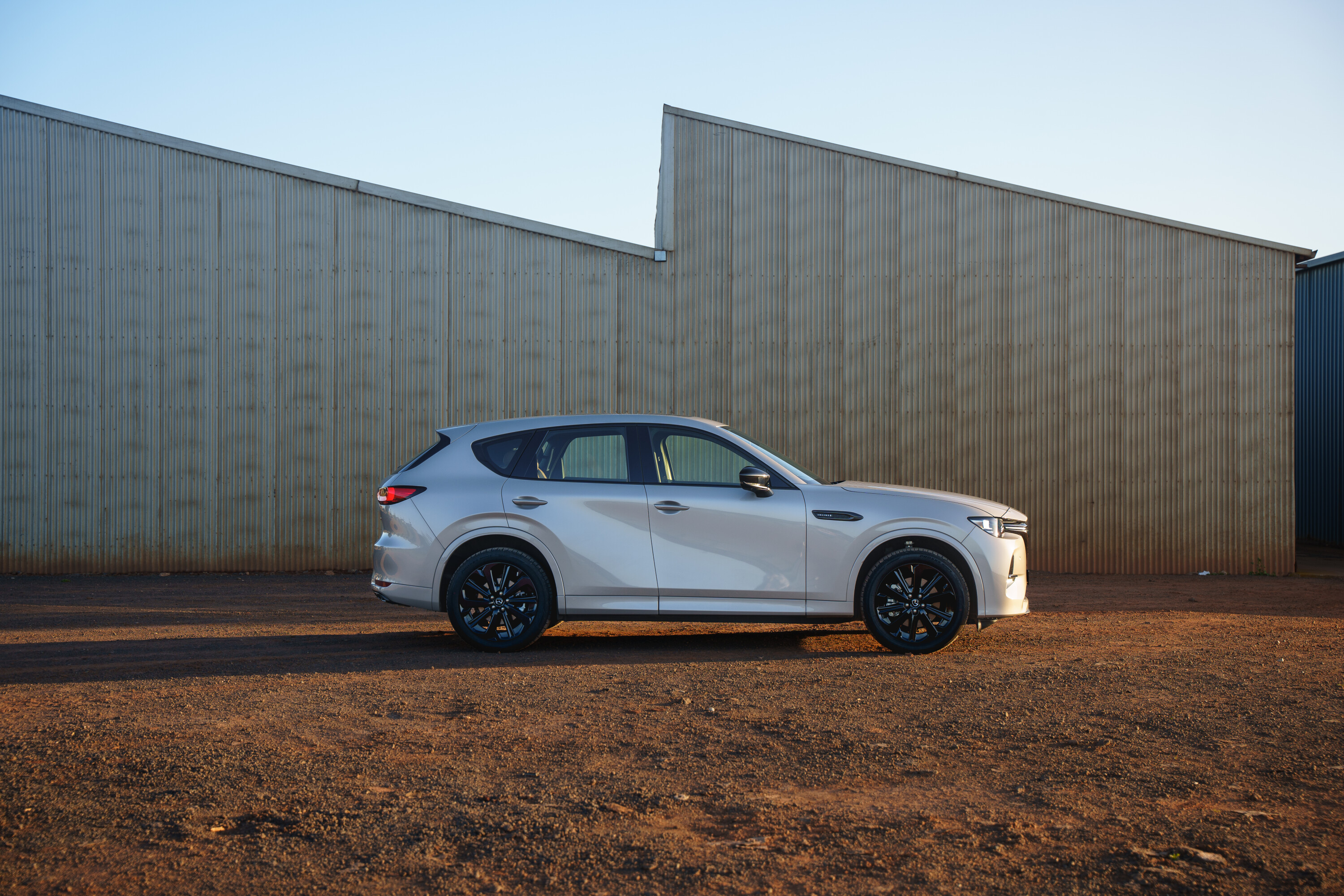
2023 Mazda CX-60 long-term review
JUMP AHEAD
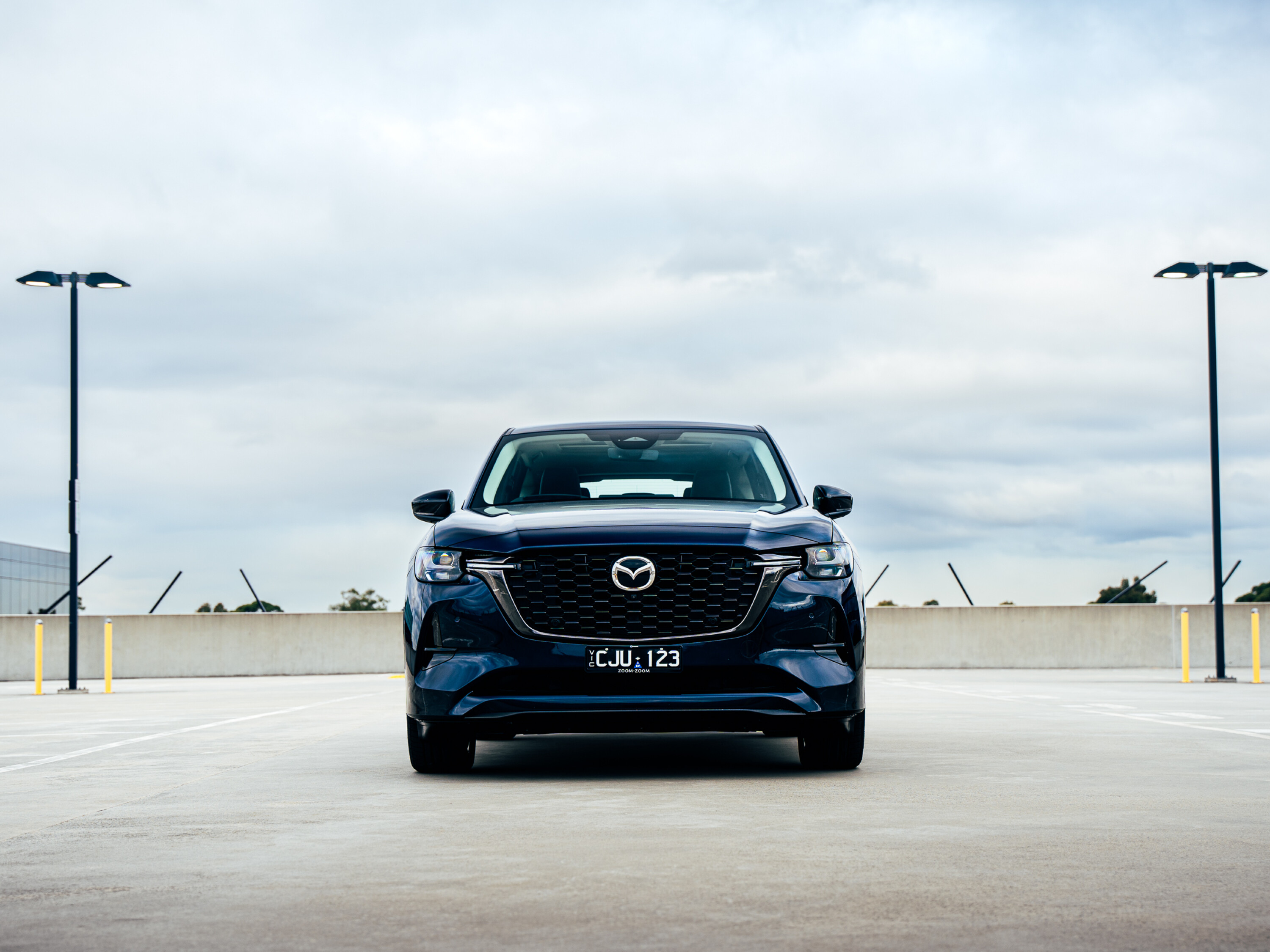
Welcome
Model: Mazda CX-60 D50E GT Vision Price as tested: $71,800 + on-road costs This month: 733km @ 6.4L/100km
Things we like so far
- Nearly everything is brand new; platform, engines, transmission
- 3.3L diesel is grunty, refined and efficient
- Engaging handling for a big SUV
Not so much…
- Ride quality is way too firm
- Powertrain is frustratingly clunky and ungainly at low speed
- Restricted touchscreen functionality of the centre display
There’s a lot riding on the Mazda CX-60’s broad, chiselled shoulders. As the debut model built off the Japanese brand’s much-hyped Large Platform, it feels like Mazda’s first proper shot at fulfilling its promise to “go premium”.
It’s also our first taste of Mazda’s new engine line-up, the CX-60 introducing three fresh powerplants under its long nose: A pair of 3.3-litre inline six-cylinder turbos (one petrol, one diesel) and the brand’s first plug-in hybrid, which combines Mazda’s existing 2.5-litre petrol with a 17.8kWh battery and single e-motor.
But here’s the thing; when we drove the CX-60 for the first time at the local launch, we were a little underwhelmed. The engines were impressive and the cabin felt luxurious, but the CX-60’s sense of ‘premiumness’ was let down by suspension that was too firm and a gearbox that was jerky and cumbersome.
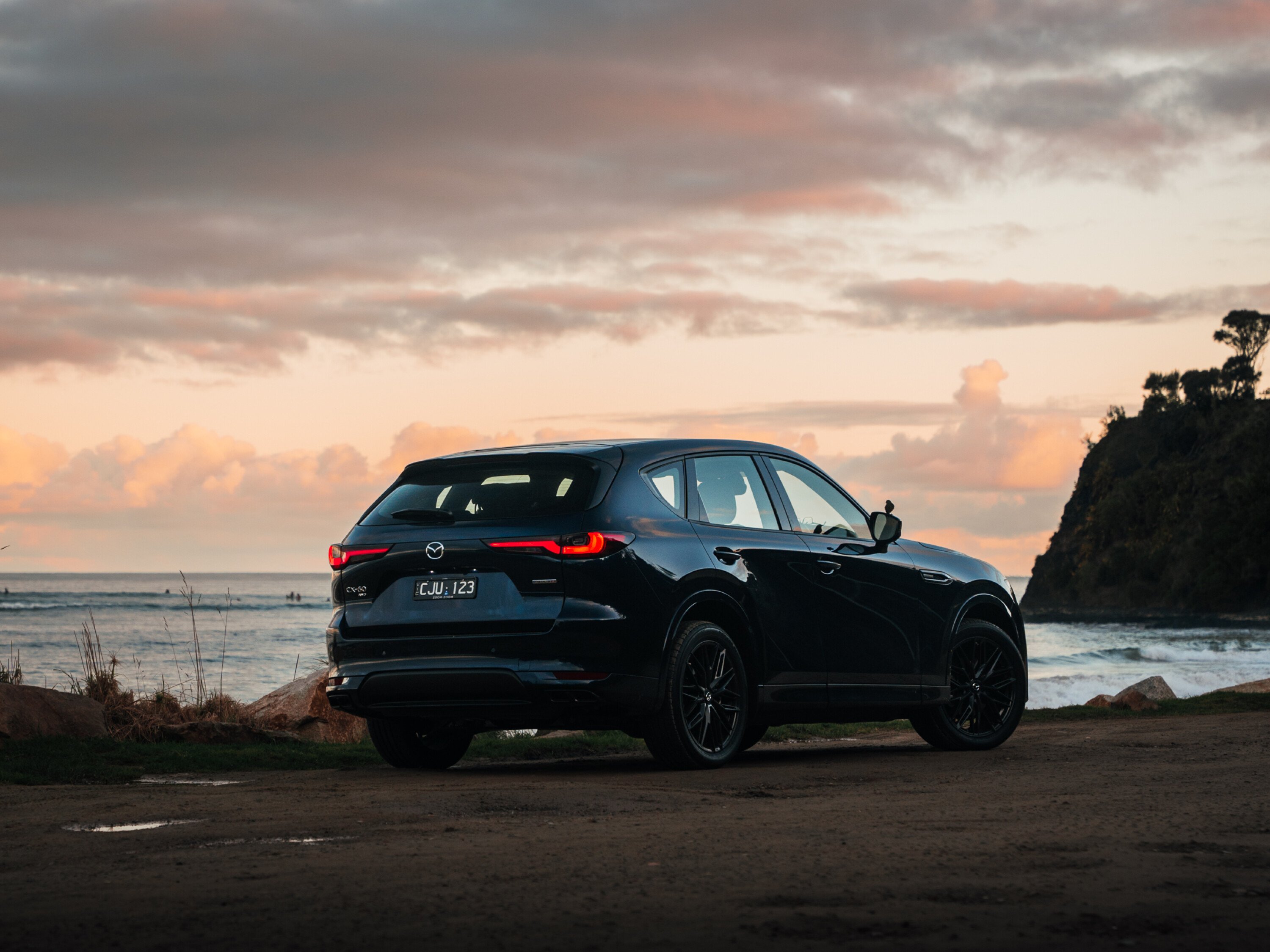
It felt uncharacteristically underdone by Mazda standards and that raised more questions than answers.
Which is exactly why we wanted to add a CX-60 to our long-term test fleet. Over the next three months, we’re going to test all three engines and also sample two of the three available trim grades as we look to get further under the CX-60’s skin.
School runs, weekends away, fast country-road blasts and inner-city driving are all part of the plan to better understand the CX-60’s strengths and weaknesses. First up is the mid-spec CX-60 GT with the 3.3-litre diesel. It’s fitted with the optional $2000 Vision Pack which takes its RRP to $71,800 before on-road costs. Here’s how month one played out.
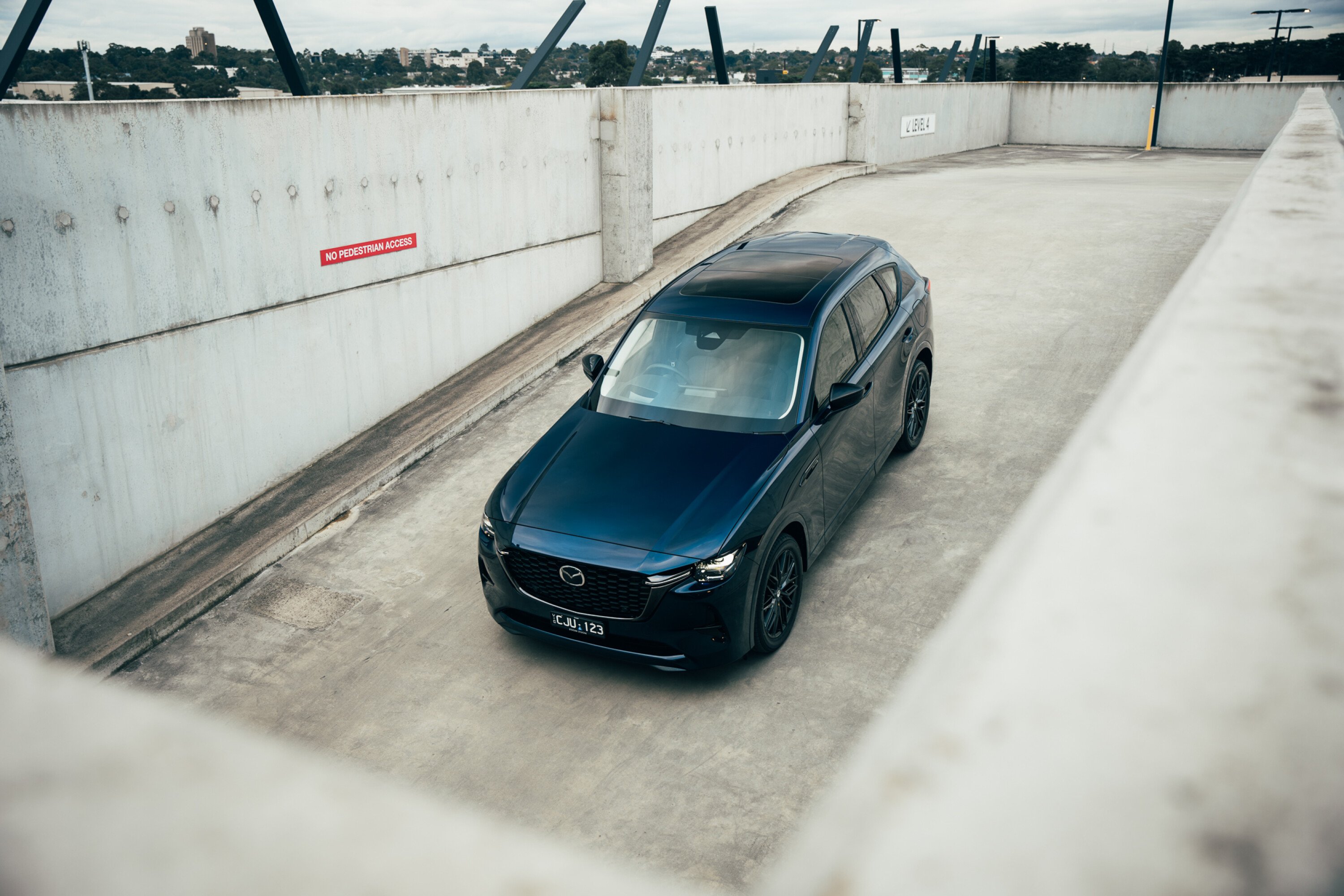
Day 1
Collection day from Mazda HQ and first impressions are overwhelmingly positive. Mazda’s mid-size flagship looks great, which is a big relief. In pictures, the CX-60 can look a touch slab-sided and blocky – I’ll admit to having some reservations about the exterior design – but in the metal, it translates into a medium SUV that has real presence.
Great cabin, too. Our mid-spec GT tester has a slightly sombre colour scheme but its mix of black leather and dark plastics still feels premium and everything is tightly screwed together.
And the fundamentals are all there: a sporty ‘legs out’ driving position, comfy seats, decent storage and an elegant, leather-trimmed steering wheel.
It also feels impressively well-equipped for a mid-spec model. There are heated leather seats, a heated steering wheel, a panoramic sunroof and wireless phone charging. The tech on offer is impressive, too.
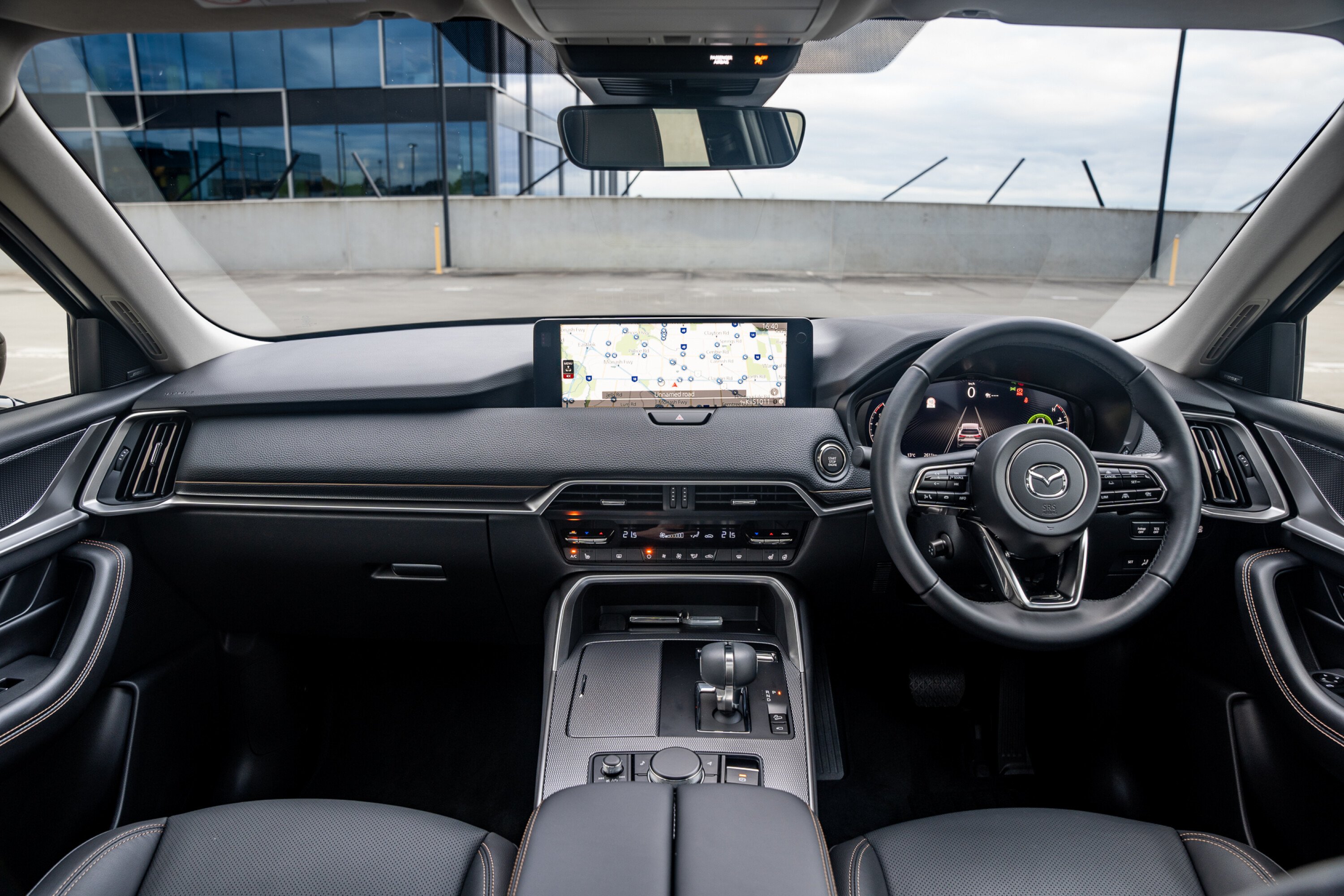
The digital dial cluster and head-up display are both clear and adorned with elegant fonts (BMW could learn a thing or two from the simplicity on display here) and the 12.3-inch centre screen is Mazda’s biggest yet.
But the absolute best thing about the CX-60’s cabin? How simple it is to use. There are buttons for all the key controls, the ergonomics are bang on, and the design is restrained and tastefully done.
Is it Mazda’s best cabin yet? Absolutely. Does it feel comfortable and premium? Yes on both fronts.
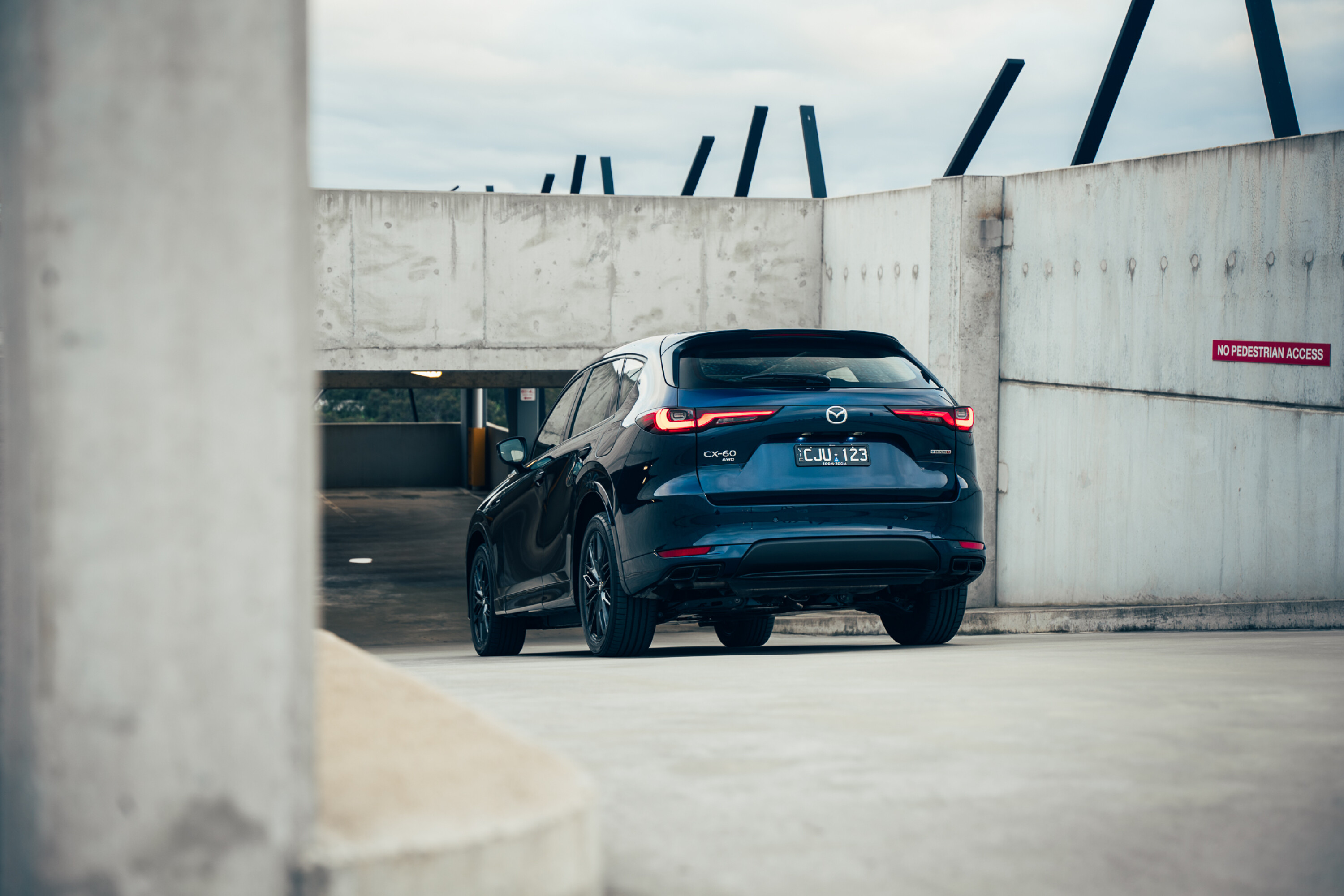
Day 7
We’ve hit a few speed bumps, folks. Given the CX-60 focuses on luxury and Mazda’s desire to go premium, I was expecting the CX-60’s suspension to be soft and pillowy.
But the opposite is true – it’s surprisingly taut and sporty. GT models and above ride on 20-inch alloys (the base Evolve has smaller 18s) and the ride quality is overly firm in everyday driving. It even verges on harsh over really rough roads, which is a shock given Mazda typically nails the compromise between sporty handling and everyday comfort.
A bigger issue, however, is the transmission. The eight-speed unit was developed in-house by Mazda and it’s unpleasantly clunky and jerky at low speed. The shift logic feels at odds with the torquey diesel, too.
Rather than surfing the torque in stop-start traffic and holding the same gear as you blend in the throttle, the auto is overly keen to kick down, which makes the CX-60 feel cumbersome rather than effortless. It’s a ’box that rarely feels like it’s in the right gear at the right time, meaning it’s easy to ‘catch it by surprise’ and then be forced to wait as it shifts down a cog.
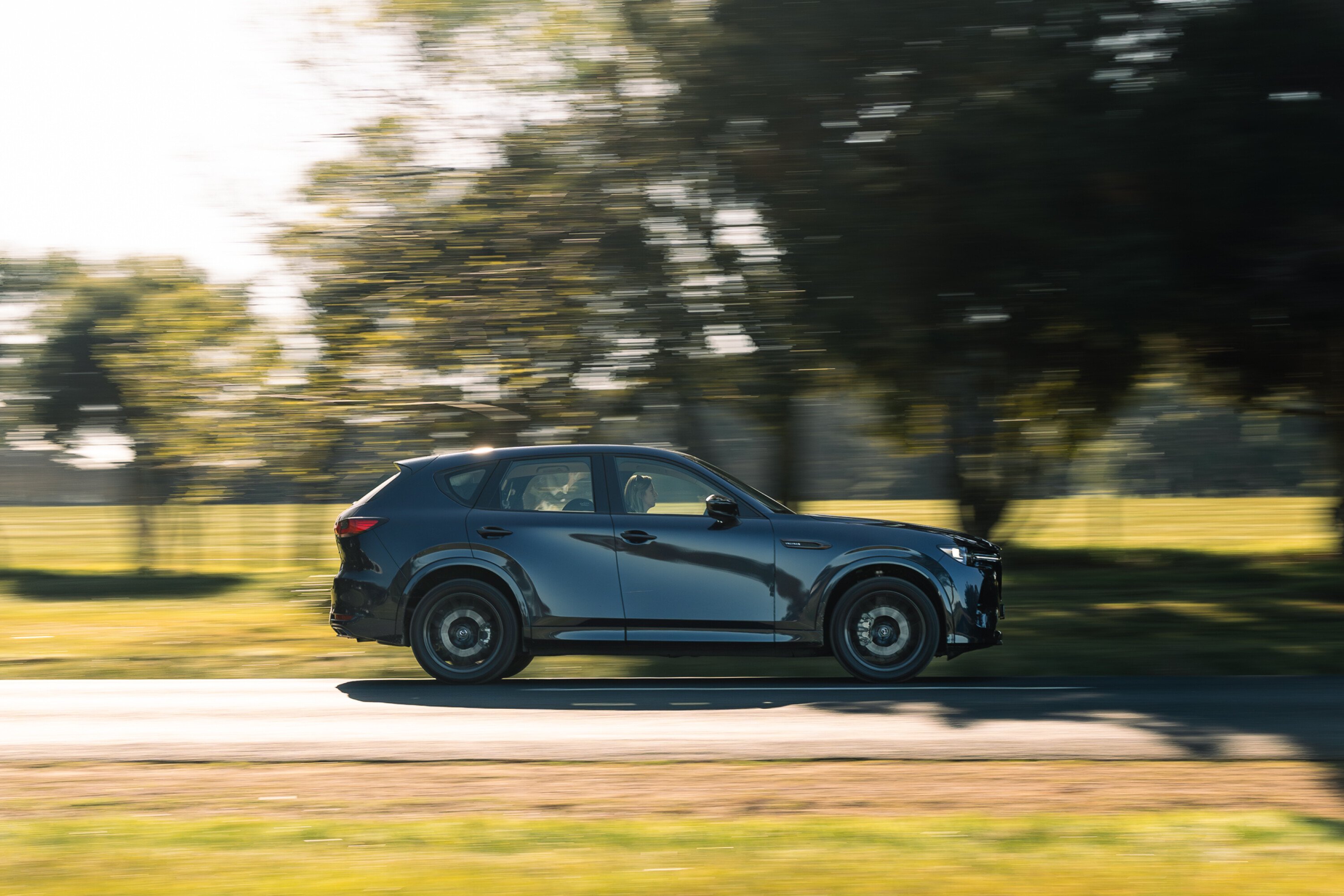
Some odd noises have also started to appear. There’s a pronounced grinding from the drivetrain at low speed when you lift off the throttle, almost like the clutch is partially engaged or a bearing is scraping.
And I’ve noticed a peculiarity about the diesel’s soundtrack. Most of the time the big 3.3-litre diesel sounds impressively tough – fake noise is played through the speakers to give it a deep, almost V8-like soundtrack – but on start-up it takes a few seconds for the augmented noise to begin.
So you get a burst of genuine diesel sound before the deeper, more pronounced fake noise starts, which spoils the illusion a little.
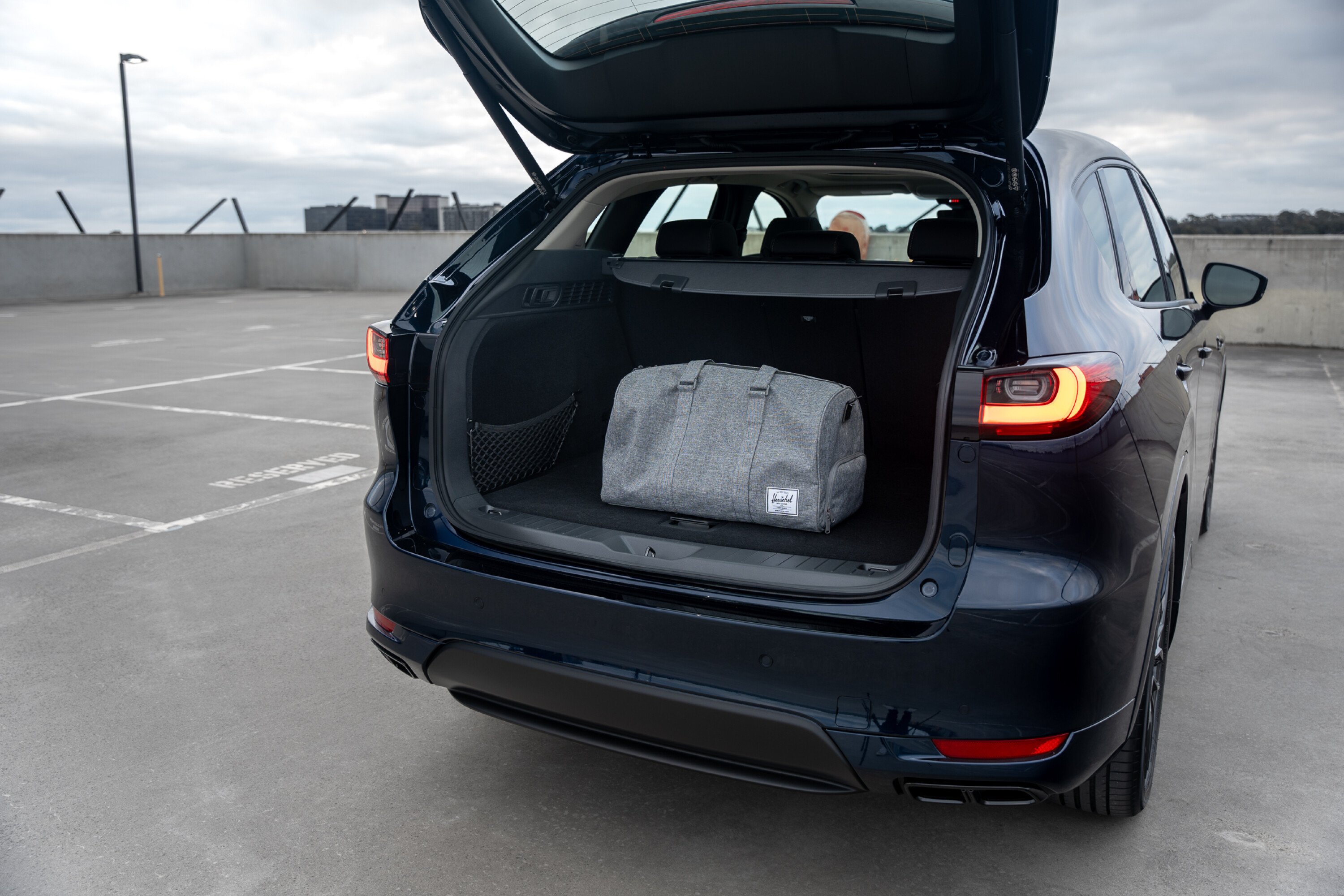
Day 14
Time to stretch the CX-60’s legs. We have a family holiday planned by the seaside, which should provide the perfect opportunity to test the Mazda’s open-road behaviour.
But first, the boot. We’re only a family of three but we don’t pack light. Multiple suitcases, a high chair, a travel cot and enough kids’ toys to entertain a small city are all crammed into the CX-60’s rear end and it all fits comfortably.
Officially the CX-60 offers 570 litres of luggage capacity behind the rear seats, which puts it on par with a Toyota RAV4 and Nissan X-Trail but miles ahead of other mid-size rivals like a Honda ZR-V (380L) and even the Mazda CX-5 (438L).
The driving experience also improves away from the city. This is a great engine. The 3.3-litre turbo-diesel is entirely new and it feels modern, powerful and responsive.
With 187kW/550Nm on tap and a 48-volt mild hybrid subsystem, there’s ample performance to execute easy overtakes and it’s impressively quiet at a cruise.
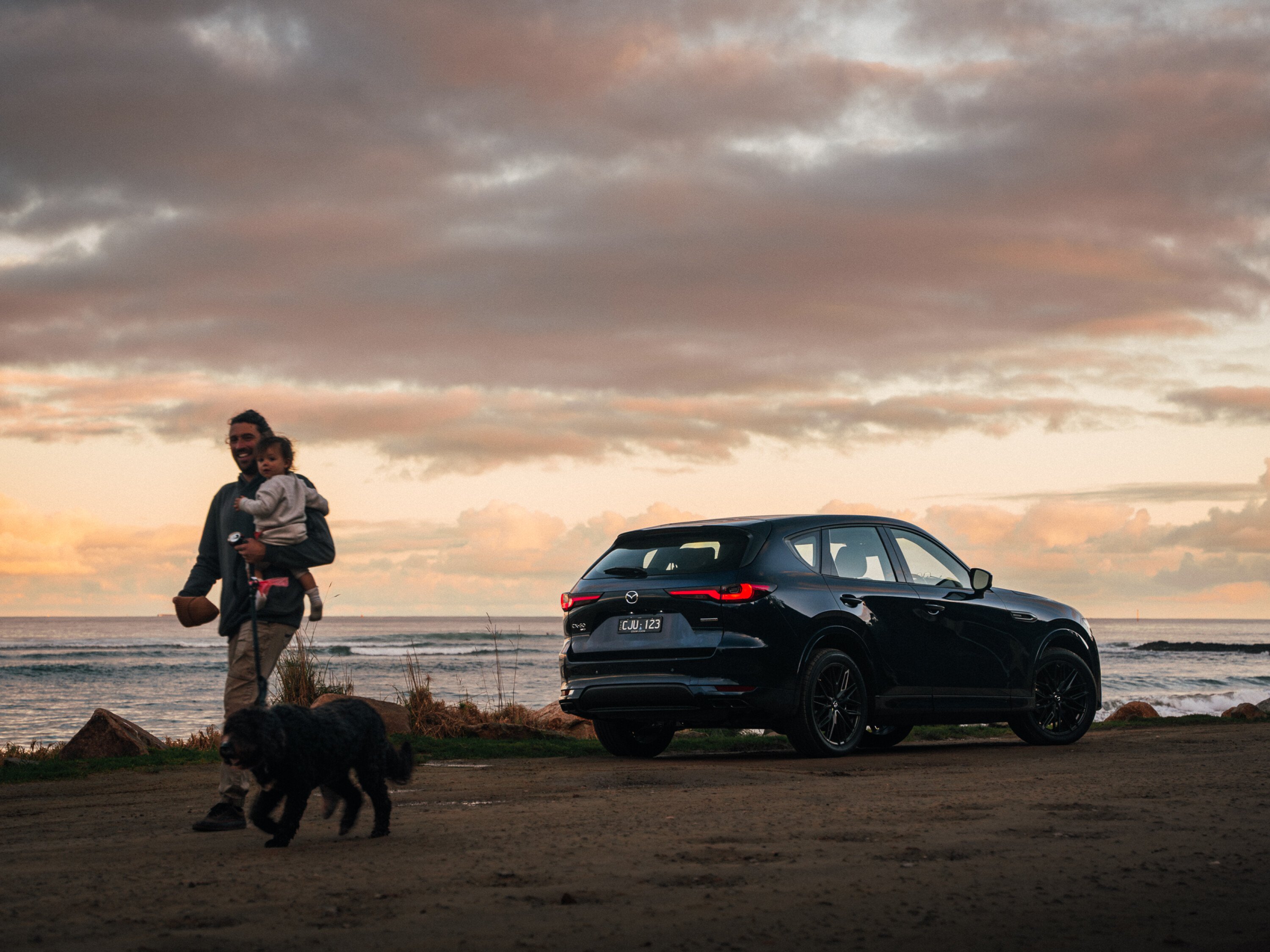
The whole car is, actually, with only some distant tyre roar on coarse chip surfaces spoiling the cabin’s serene sense of calm.
It’s surprisingly engaging to drive on twisty roads, too. Body roll is nicely contained and the steering is meatily weighted, which combines with the grunty engine to make the CX-60 a fun SUV to pedal quickly.
But is that the right focus for a family car? I’d happily give up some of that handling nous for some extra ride comfort…
No complaints about the rear seat. There’s ample room for adults to sit behind one another, there are dedicated rear air vents, tri-zone climate control and the backrest folds 40:20:40.
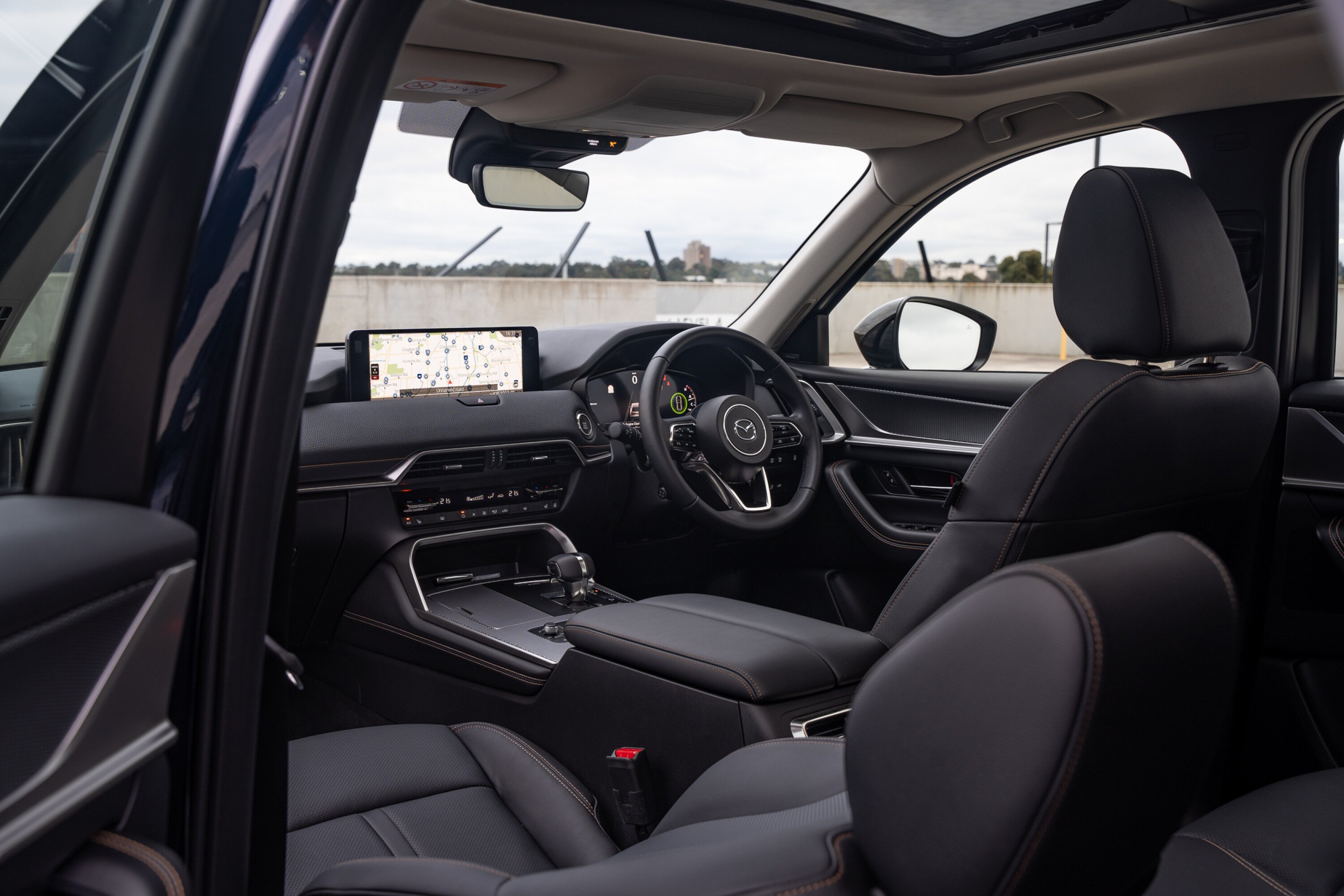
Day 21
After 700km or so, the CX-60 needs a drink. I’ll admit to some concerns here. At 1990kg, the CX-60 is no lightweight, and the 3.3L diesel is a big engine by modern standards so it could be thirsty.
Clearly, I worry too much. With the tank brimmed, the Mazda swallows 47L of diesel to return a real-world economy figure of 6.4L/100km. Given it took in a fairly even mix of urban and freeway driving, that’s impressively frugal.
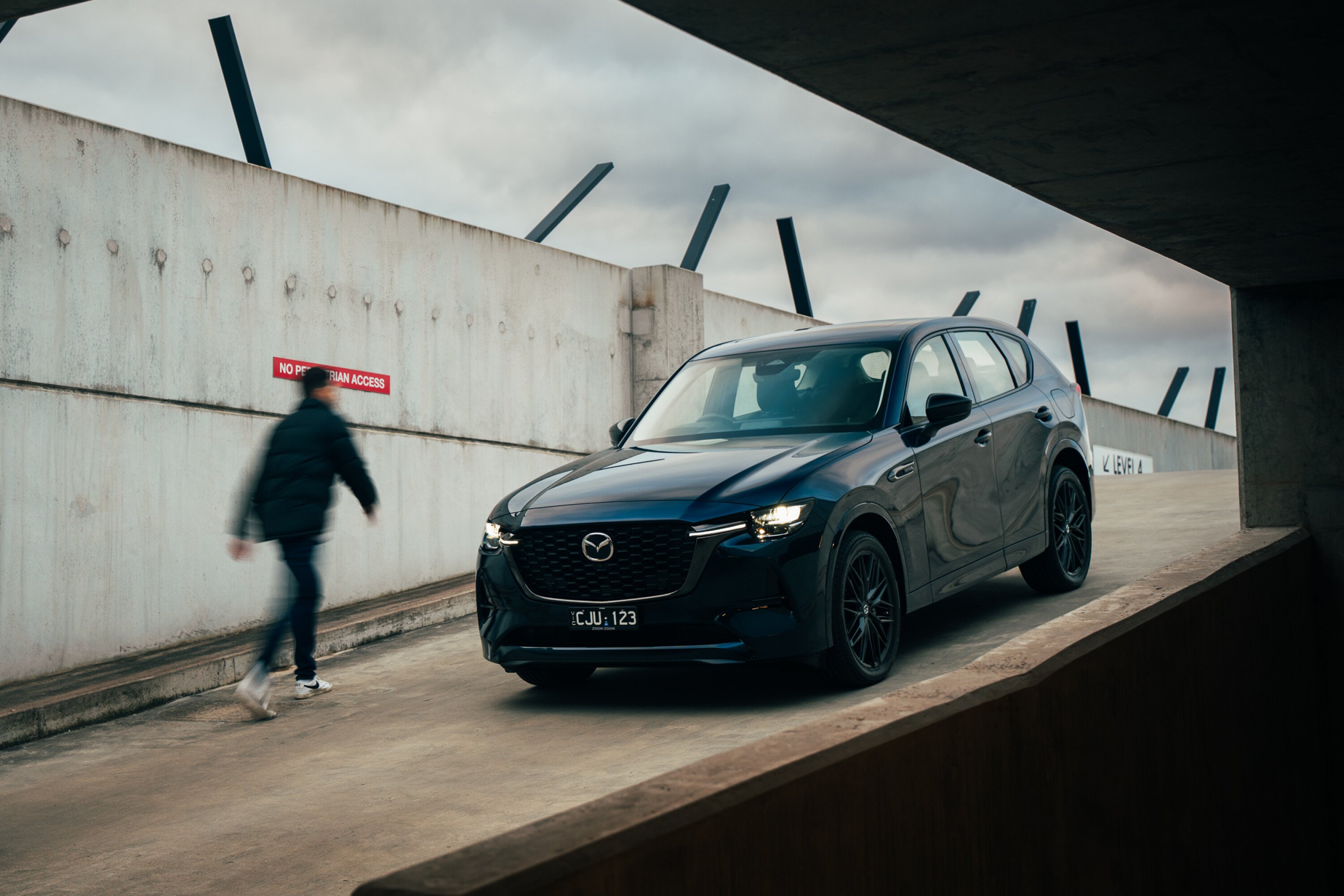
Day 30
It’s swap day, which means the 3.3L diesel is heading back to Mazda and will be replaced with the plug-in hybrid. The drive back to Mazda’s HQ gives me time to reflect on how CJU123 has stacked up. The bones are good, there’s no doubt about that.
The exterior design is sharp, the cabin is nicely executed and the diesel is a highlight. Kudos, too, for Mazda’s sheer ambition in building a brand new platform, its own gearbox and three fresh powertrains. But for all the core goodness, the diesel CX-60 lacks some finesse.
Its transmission is the weakest link, followed by the overly firm ride, though both of these issues should be able to be ironed out come facelift time. It’s also possible the PHEV’s injection of some instant, low-down electric assistance could help soothe the CX-60’s low-speed jerkiness. Tune in next month to find out.

PART 2
Goodbye diesel and hello hybrid as Inwood slips into Mazda’s first-ever plug-in
- Model: Mazda CX-60 P50E GT Vision
- Price as tested: $82,900
- This month: 554km @ 6.5L/100km
Things we like
- PHEV is surprisingly quick for a big family SUV
- Hybrid version has a higher braked towing capacity than diesel
- Longer servicing intervals than diesel
Not so much…
- Ride quality is still too firm
- Powertrain is frustratingly clunky and ungainly at low speed
- PHEVu2019s real world economy gains are minimal
Let’s face it, Mazda hasn’t exactly been a trail-blazing pioneer when it comes to electrification.
Where rival brands like Hyundai, Kia and Toyota have all forged ahead with multiple hybrid and fully electric models, Mazda has been slower to dive head first into the world of excited electrons.
And that’s entirely understandable. Aussies tend to have a warped view of Mazda simply because it’s so successful here. Thanks to a hard won reputation for excellent customer service and for making cars that are reliable and fun to drive, Mazda is a sales juggernaut Down Under and has long been our country’s second-best selling brand.
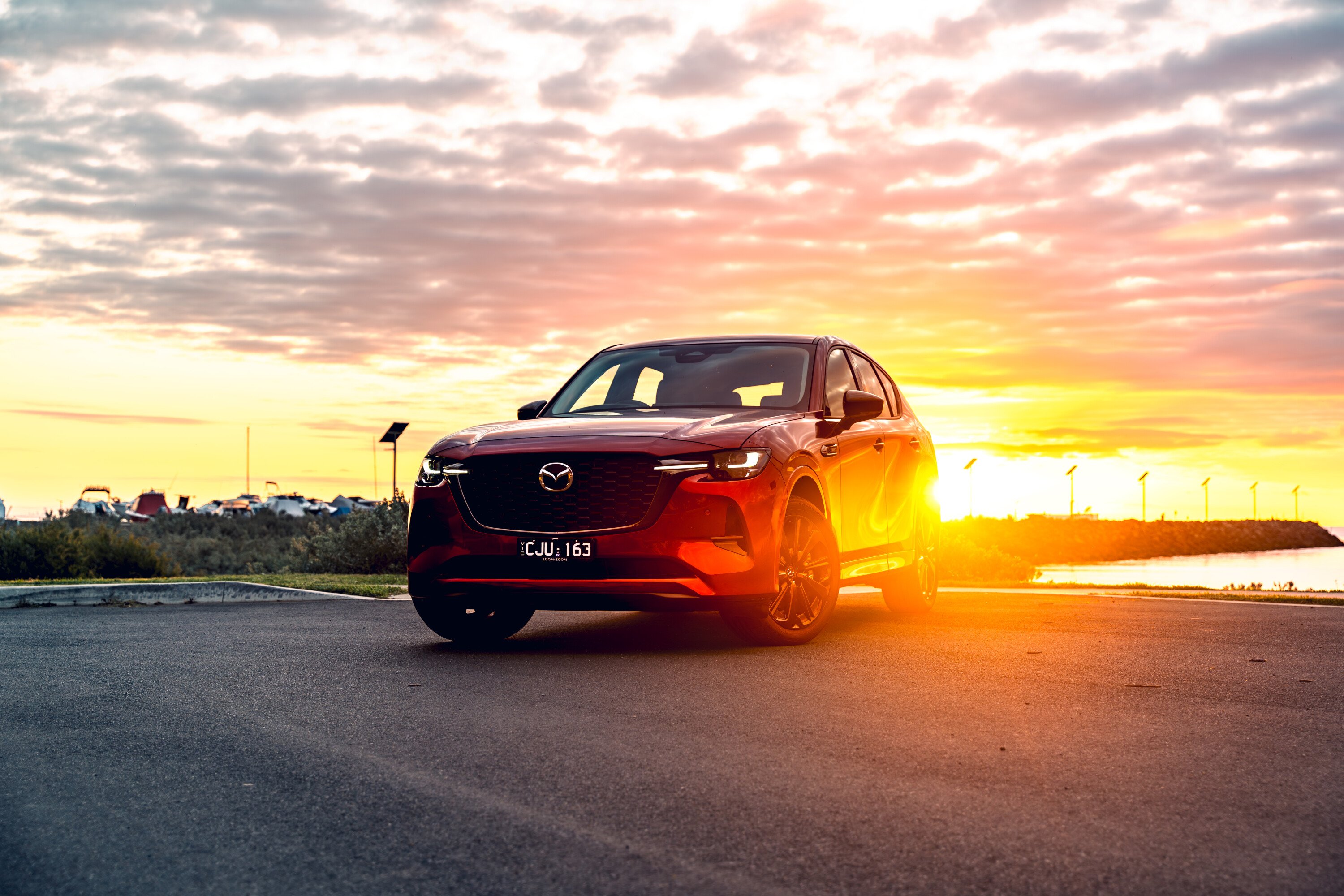
Globally, however, it’s a much smaller player. Crunch the number for 2022 and Mazda doesn’t even scrape into the top 15 for worldwide sales.
And unlike lots of other brands, Mazda isn’t nestled within the secure bosom of a large parent company either, so every new model and every major investment has to be successful. The risks of a large money project failing don’t bear thinking about…
All of which makes the bright red SUV you see here fairly significant. This is the (deep breath) Mazda CX-60 P50E GT Vision and it’s the Japanese brand’s first ever plug-in hybrid. And boy, oh boy, does it make a strong first impression.
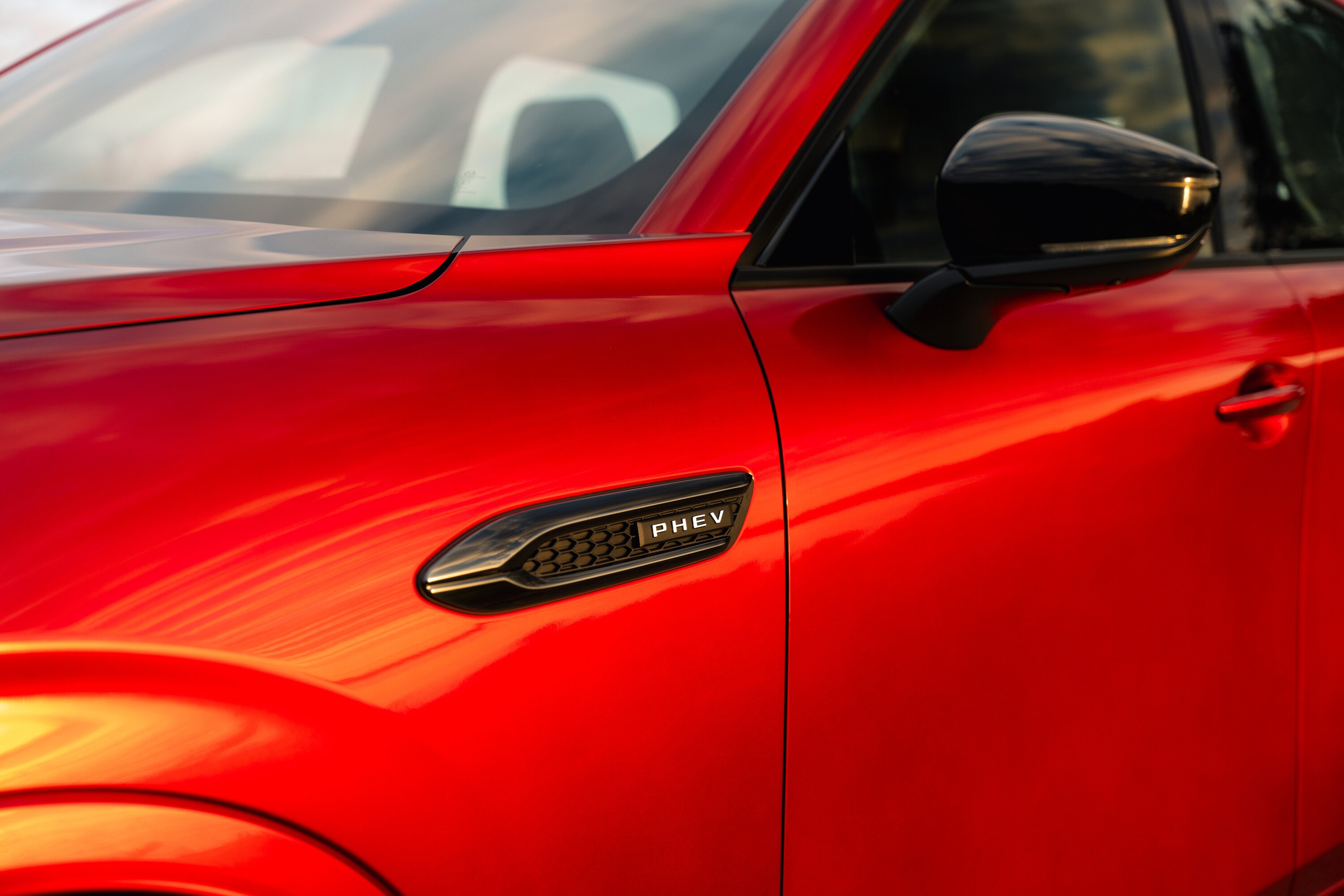
Given the ‘green’ fuel-saving image of hybrids, you might expect the CX-60 PHEV to be the least powerful and performance focused of the range but actually the opposite is true.
Run an eye over the CX-60 spec sheet and you’ll see the PHEV version churns out 241kW and 500Nm. That makes this one of the most powerful vehicles Mazda has ever made. And despite weighing a porky 2139kg (+150kg compared to a diesel CX-60) if you flatten the throttle you’ll rocket from 0-100km/h in 5.8 seconds. That’s hot hatch fast.
Be gentler with your right hoof and EV mode will also provide 76km of electric-only range, which is decent although about par for the course for PHEVs these days. A Mitsubishi Outlander PHEV, for example, offers 84km of EV range.

So far, so good then, but how does the PHEV compare to the diesel-powered CX-60 we ran in these pages last month?
The comparison is intriguing given both cars are exactly the same trim level — mid-tier GT with the optional $2000 Vision pack — meaning the only difference between them is the exterior colour and the powertrain. And sadly for the PHEV, it’s the diesel that’s the clear pick of the two…
The CX-60 PHEV combines Mazda’s existing 2.5-litre petrol engine with a single electric motor that’s fed by a 17.8kWh battery pack. The e-motor is wedged between the engine and eight-speed gearbox and even in EV mode, the CX-60 is all-wheel drive.

On its own, the electric motor makes 100kW/270Nm which is enough to propel the CX-60 about in fuel-saving silence. You’ll be lucky to make it the full 76km, however.
Like most cars, the CX-60’s official consumption figures are fairly optimistic. The battery’s claimed electrical consumption is 14.8kWh/100km but our average was just over 20kWh.
It’s the same story for fuel efficiency. Like all PHEVs, the CX-60’s official combined figure is unrealistically low at 2.1L/100km. Our fuel reading saw the PHEV drink 6.5L/100km, which is actually fractionally more than the 6.4L we used in the diesel.

And while it’s undoubtedly quick, you need to engage Sport mode for the PHEV to feel properly muscular.
And in terms of drivability and performance, the PHEV has some issues. I’d been hoping that the injection of the e-motor’s instant, low-down torque would help to iron out the loow-speed jerkiness and hesitation we encountered in the diesel CX-60 but sadly the same issues remain. If anything, they’re actually more pronounced, thanks to the occasional clumsy handover between electric-and-petrol propulsion.
And while it’s undoubtedly quick, you need to engage Sport mode for the PHEV to feel properly muscular. The petrol hybrid also lacks the refinement and smoothness of the 3.3L turbo diesel. The oiler sounds better, too, and is better at executing effortless overtakes on the open road.
All of which makes the PHEV’s price premium a difficult pill to swallow. Spec-for-spec, the PHEV is $10,941 pricier than an equivalent diesel. We know which one we’d pick…
PART 3
Flagship petrol brings some luxe appeal; gearbox and ride issues remain
- Model: Mazda CX-50 G40e Asami SP
- Price as tested: $75,750 + on-road costs
- This month: 437km @ 10.7L/100km
Things we like
- Azami trim grade + SP pack feel properly premium
- Mazda has introduced fixes for the firm ride and jerky gearbox
- 3.3L petrol is smooth and responsive
Not so much…
- We’re yet to try the updated suspension/gearbox
- Big turbo petrol is thirsty
- Azami model grade is getting pricey
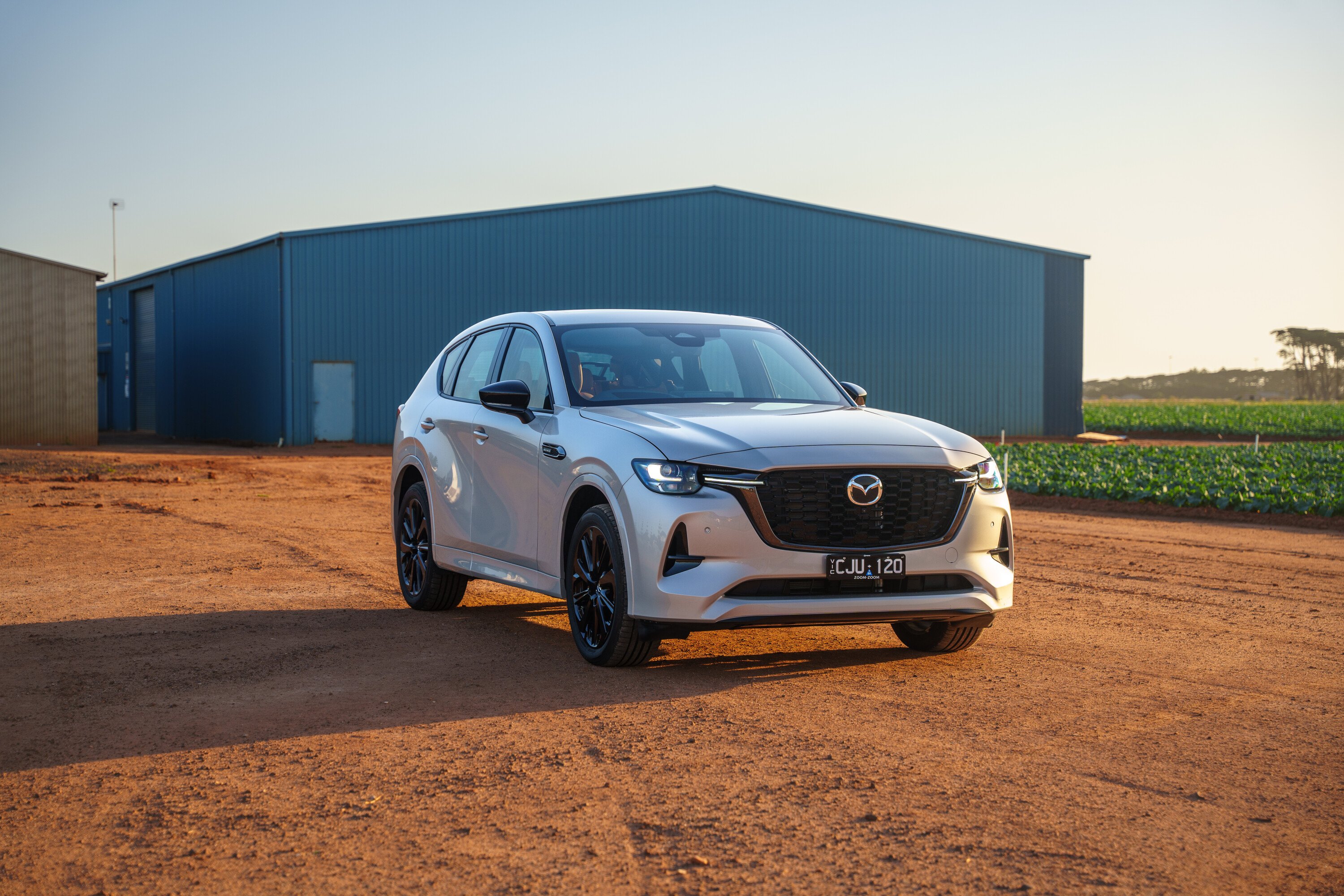
“Gee whizz, this is F-L-A-S-H!” She doesn’t know it but my friend, who is now gazing around the tan-trimmed cabin in disbelief — “Are you sure this is a Mazda?” — has just perfectly encapsulated what the CX-60 is hoping to achieve.
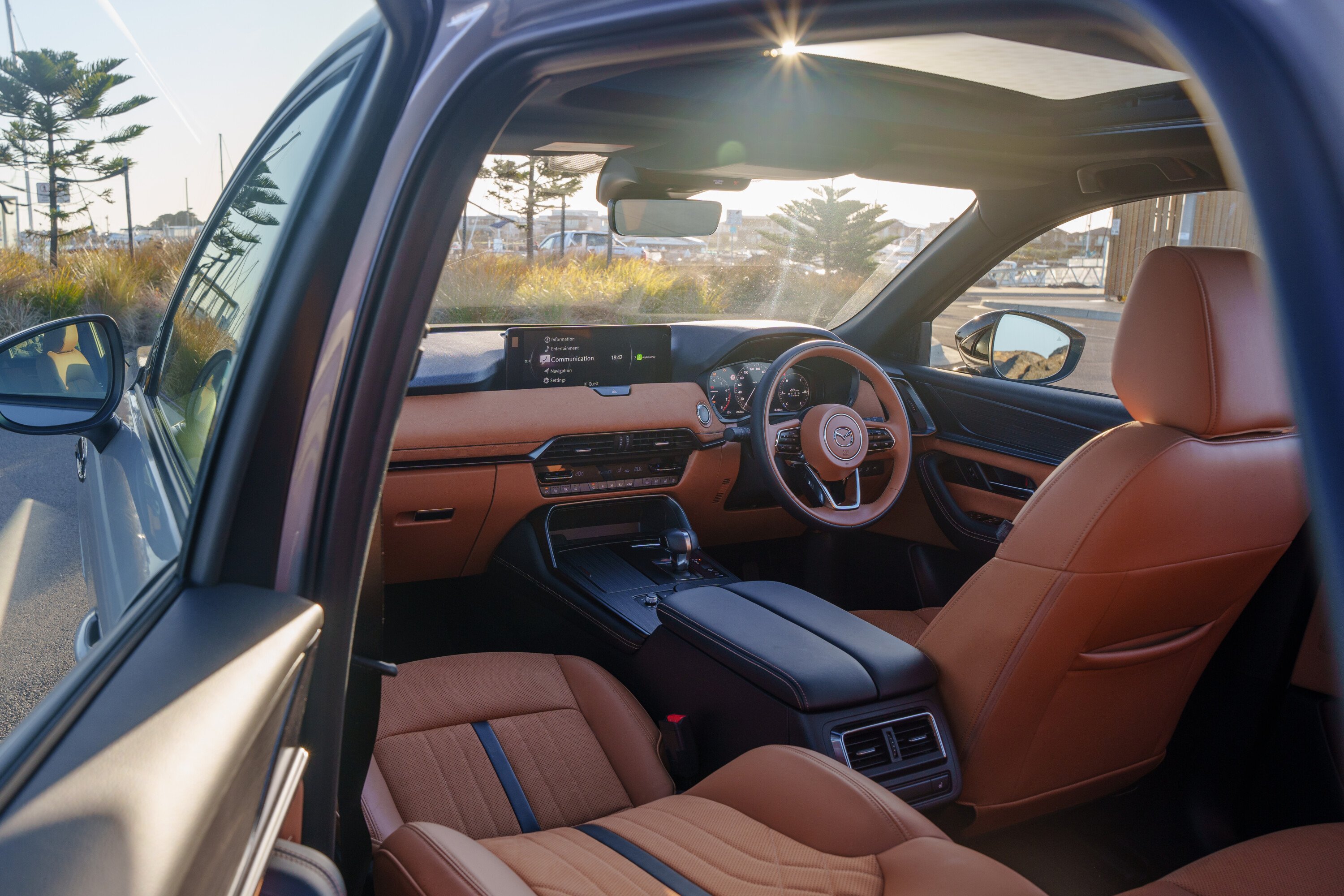
A premium push has been on Mazda’s radar for years and this kind of reaction, where buyers start to compare a humble Mazda with richer rivals from Volvo, Volkswagen and even BMW and Mercedes, is exactly what CX-60 was designed to do.
So why has it been elusive, until now? This is the third CX-60 to join the Wheels garage (our grand plan was to try a different engine and trim level each month) and while the previous examples have looked smart and felt solidly screwed together, none have elicited such a glowing response from family and friends.

Most of that is down to this CX-60’s spec. So far we’ve run mid-tier model grades but this example is the flagship G40e Azami and it brings a welcome dose of glitz and glamour.
On top of the already well-specced GT model, the Azami adds a different design for the 20-inch alloys and front grille, adaptive LED headlights, nappa leather seats, ventilated front seats, a 360 surround view camera, a frameless rear-view mirror and front cross-traffic alert.
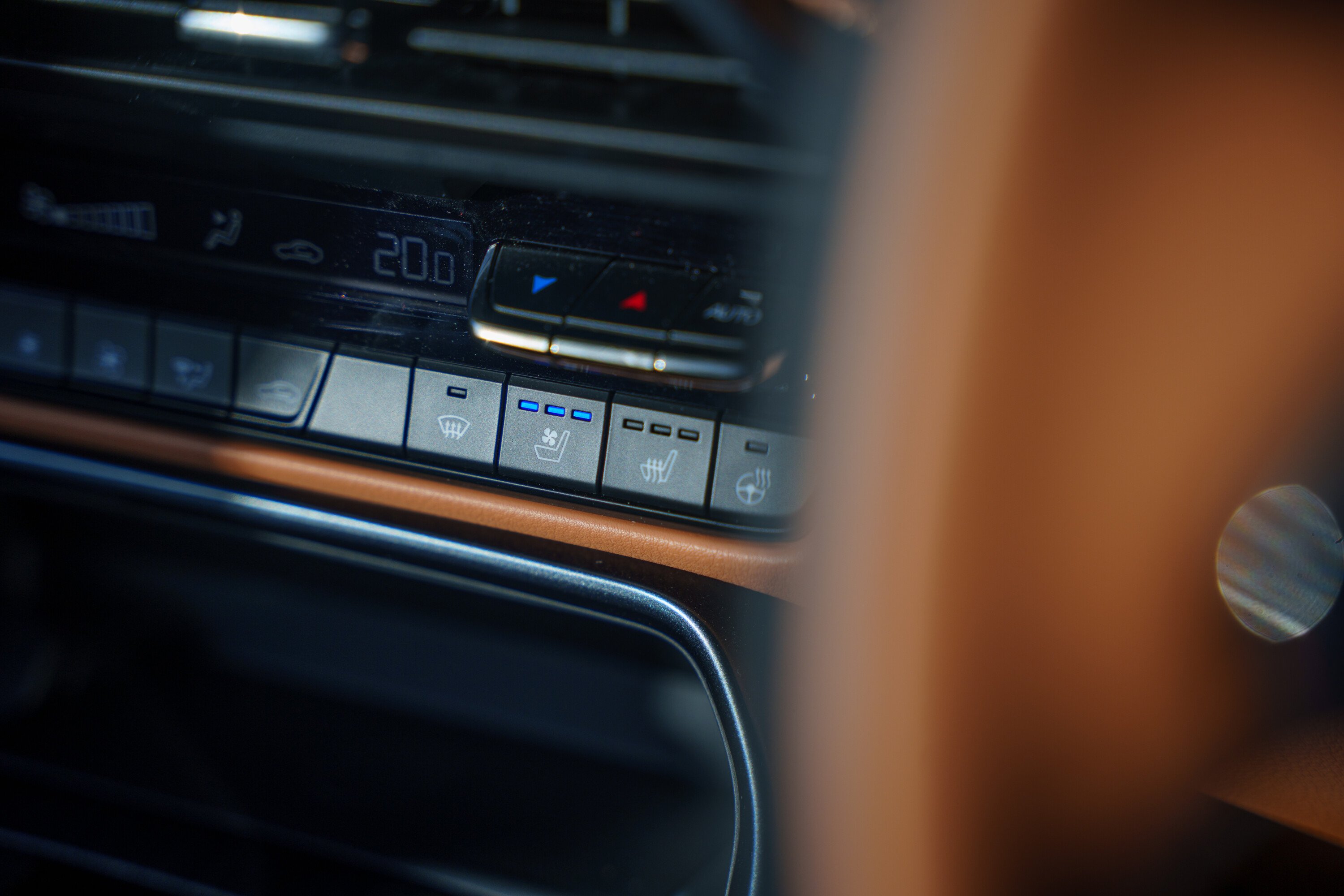
This particular car also carries the optional SP package which, for an additional $2000 dollar-bucks, adds black metallic alloys, gloss black exterior detailing and trims the seats, dash and steering wheel in tan nappa leather.
It’s a tasteful tan, too — more Ferrari-esque than the orange-hued tan leather you get in a Mitsubishi Outlander — and it’s a big part of what elevates this CX-60’s cabin from “Oh this is nice” to “blimey, this is fancy!”. The perforated backrest inserts are even diamond stitched and the overall result is a cabin that fully delivers on its promise to look and feel premium.

Naturally, though, you have to pay for the privilege. With the optional SP pack included, this Platinum Quartz CX-60 will set you back $75,750 of your hard-earned, before on-road costs. We’re firmly entering premium territory, then, and for the same money you could score an AWD Volvo XC60. A base model BMW X3 isn’t that far away, either…
Neither of these rivals have a thumping great six-cylinder engine, mind. We’ve already sampled the CX-60’s diesel and plug-in hybrid powertrains and this month we’re switching to the 3.3-litre turbo petrol. Of all the donks, this is the one I’m most excited about. Like the similarly sized diesel, the 3.3L petrol is all-new and arranges its cylinders in a straight line rather than a Vee for the promise of greater smoothness and, hopefully, a more evocative sound.

Outputs sit at a healthy 209kW/450Nm, and Mazda claims the new donk is gutsy enough to propel the 1950kg petrol CX-60 from 0-100kmh in 6.9 seconds.
It’s a good engine, no doubt, and we’ll applaud any company still willing to invest in an entirely new combustion architecture in 2024, but the 3.3L petrol falls short of being great. Weirdly, it sounds more like a V6 and while it is responsive and quick, it’s not as eager or as effortless as the torquier 3.3L diesel, especially around town.
By modern standards, it’s a bit of a drinker too. Both 3.3L units are mild-hybrids but the petrol drank 10.7L/100km over a mix of urban and highway driving, which is well up on the 6.4L we saw in the diesel. That’s a 67.2% increase for any maths nerds out there.
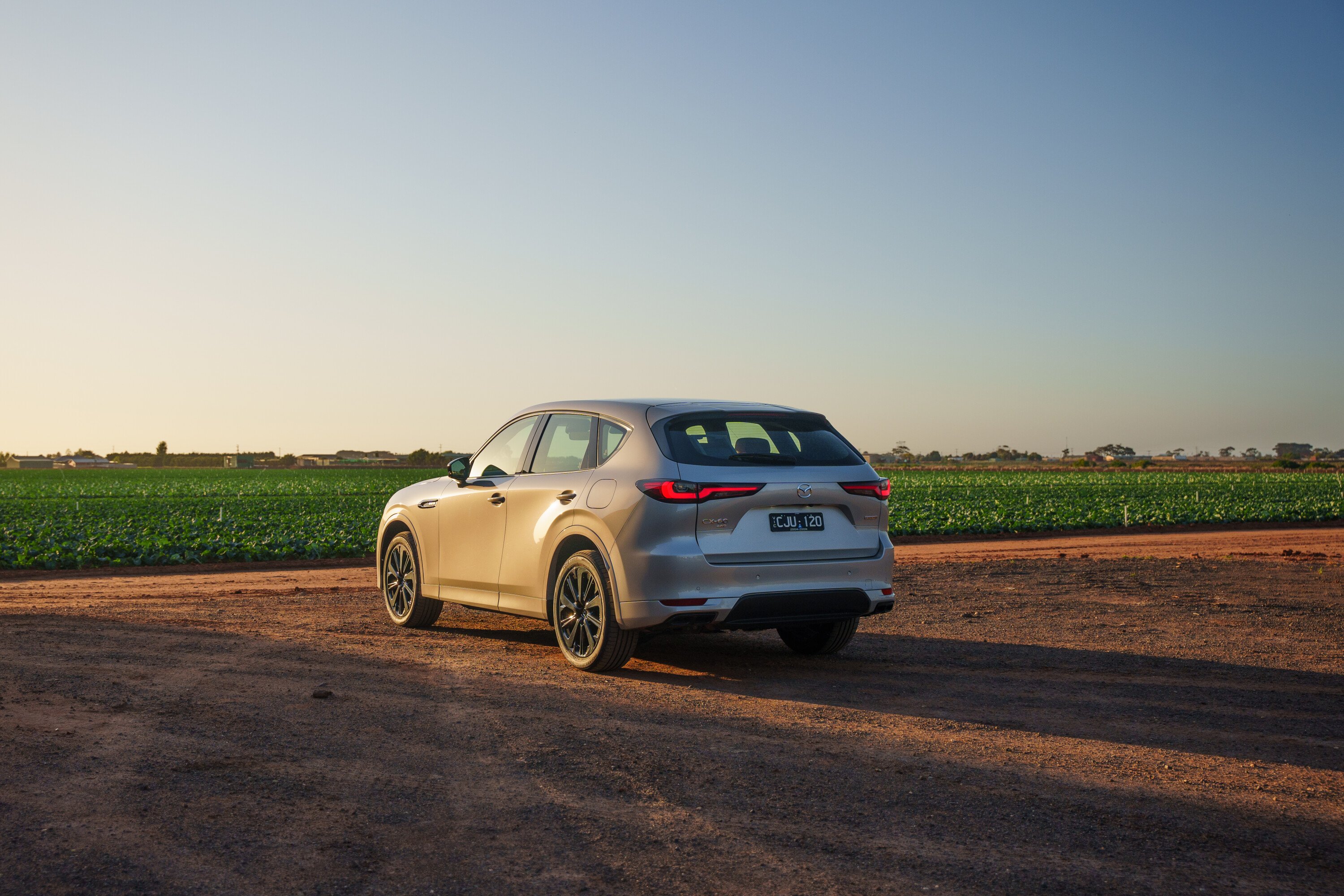
So what have we learned over the last three months? Well for a CX-60 to feel properly posh, we now know you need a flagship Azami and either the optional SP or Takuma packages. Both packs are $2000 and are a must if you want a cabin that feels a step above Mazda’s usual (admittedly excellent) interiors.
We’d also tip the diesel as the best engine on offer, with the 3.3L petrol a close second and the clumsy and expensive — but fast — plug-in hybrid the least easy to recommend.

The bigger thing for Mazda to focus on, however, is how the CX-60 rides. All three of the cars we tested felt too firmly sprung, especially over potholes/speed bumps and on poorly maintained country roads.
On this front, though, we have good news: Mazda has listened to customer feedback and is now offering buyers the chance to fit different rear dampers free of charge. We’re yet to try the revised set-up, though applaud Mazda for offering a fix. Here’s hoping adaptive dampers are on the agenda come facelift time, which should go even further to delivering a more suitable ride.
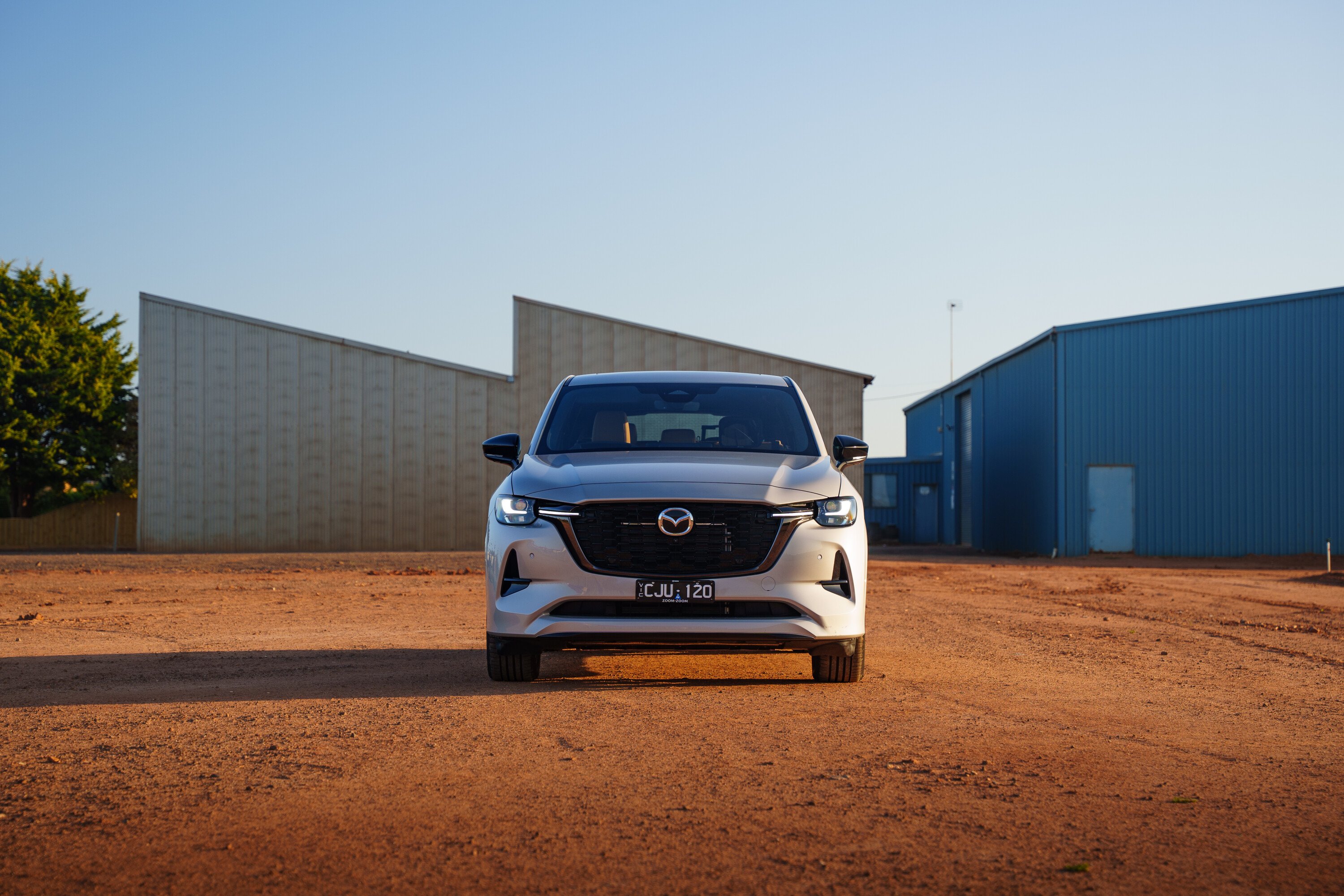
Mazda is also offering a fix of sorts for our other primary CX-60 criticism: its jerky and laggy eight-speed automatic. An update to the powertrain control module is designed to iron out the gearbox’s issues, which are most obvious at low speed and can make the CX-60 feel dim-witted.
Again, we’re yet to try to an updated CX-60, but if Mazda can improve the ride and gearbox, there’s a great family SUV here just waiting to emerge. Until then, the CX-60 isn’t so much a genuine rival to the established premium players as a foreshadowing of what’s possible.
It’s handsome, spacious, well equipped and, providing you can stretch for an Azami, genuinely luxurious. It just needs some finesse, which Mazda is already injecting.
We recommend
-
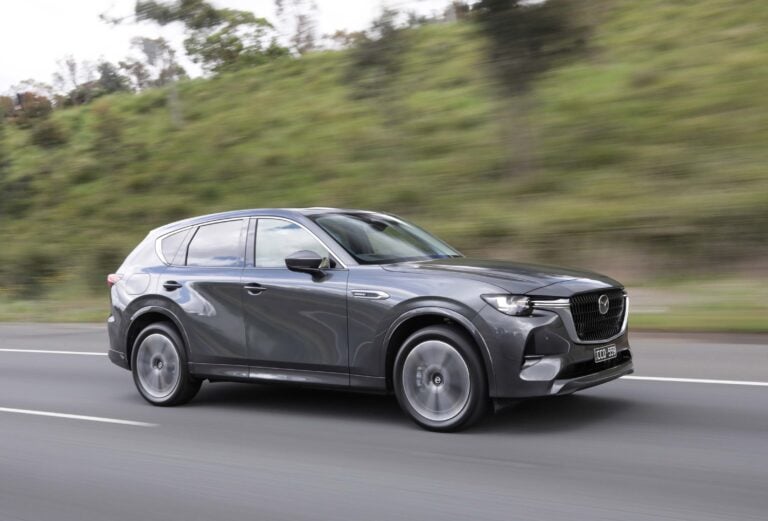 News
News2023 Mazda CX-60 pricing and features, accessories announced
CX-60 brings a new platform, fresh engines and is Mazda’s first plug-in hybrid. It’s also one of the most expensive Mazdas ever…
-
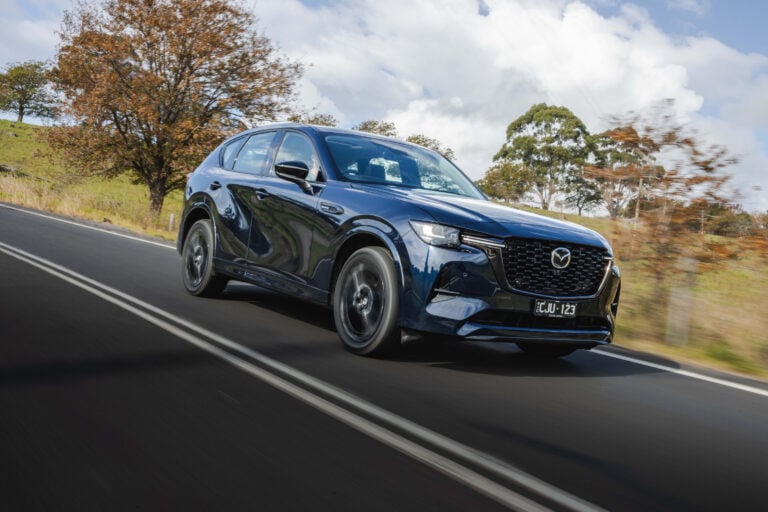 Reviews
Reviews2023 Mazda CX-60 review: Australian launch
It’s a Mazda unlike any other, but is the CX-60 worthy of the brand's ambitious upmarket foray?
-
 News
NewsNew car calendar 2026: All the new cars coming to Australia next year
Here’s the WhichCar by Wheels guide to all the new cars that will launch in Australia in 2026. Check back in regularly for updates...




